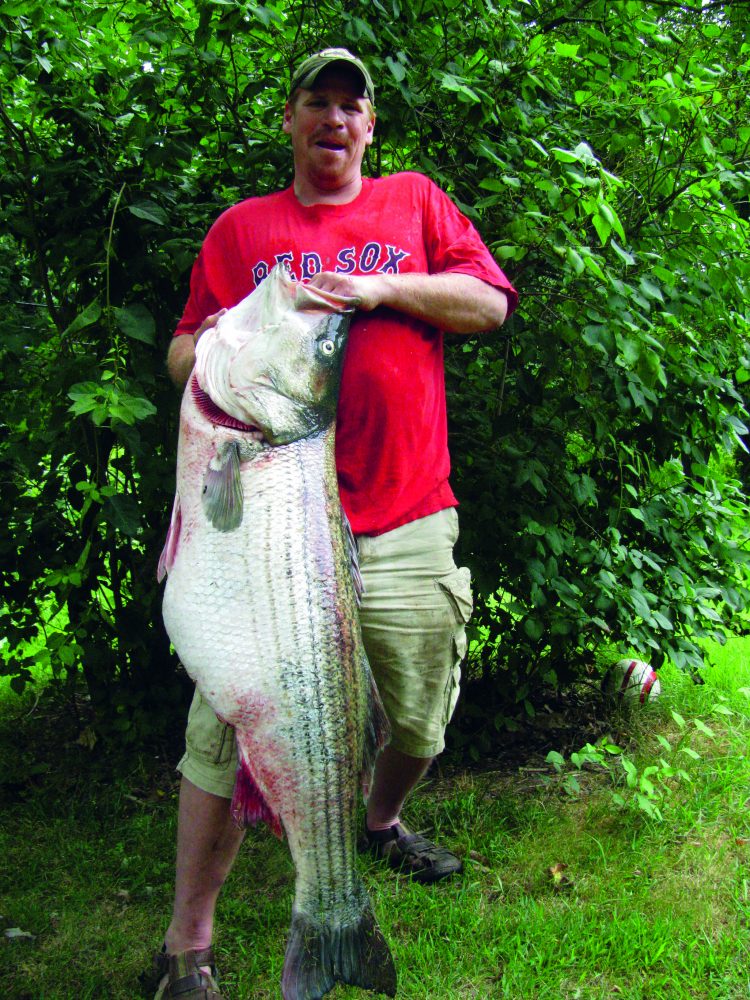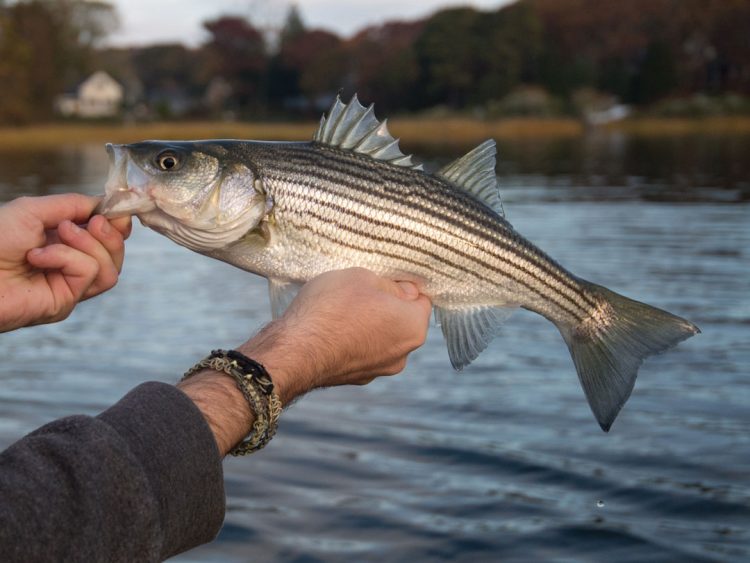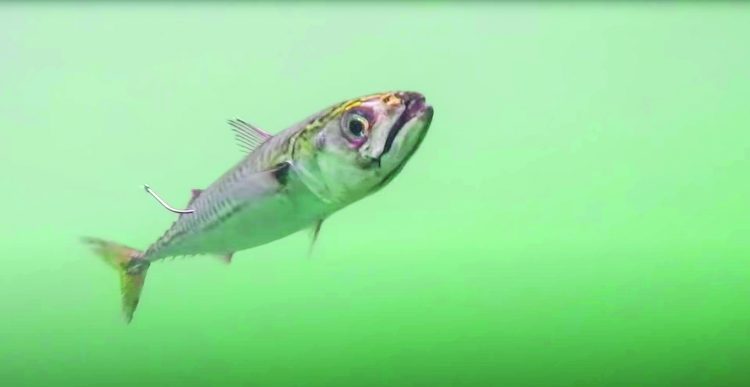How to Catch Striped Bass
Learn what it takes to catch one of the largest and most popular migratory saltwater fish in the Atlantic Ocean.

Striped bass are the most popular and sought-after saltwater species in the Atlantic Ocean from Virginia to Maine. Striped bass can be found in freshwater rivers, estuaries, along sandy beaches, boulder fields, in deep rips, and the open ocean.
They are aggressive predators, grow to large sizes, and are strong fighters. They can be caught from boats, kayaks, and from shore, making them one of the most accessible saltwater species in the Northeast and mid-Atlantic.
Where do Striped Bass Live?
Striped bass can be found from the outlet of the Mississippi River in the Gulf of Mexico to Nova Scotia, Canada. Many rivers in the Southeast and Mid-Atlantic have resident populations of striped bass, while a large migratory stock, originating in the Chesapeake Bay tributaries, Delaware River, and Hudson River, undergoes long, open-ocean migrations between Virginia and Maine in search of optimal tempatures and abundant baitfish. There is also a distinct population of striped bass that spawns in the rivers of the Canadian Maritimes.
Generally, the Atlantic migratory stock of striped bass spend the summer in the cooler waters off eastern Long Island and New England, the winter off Maryland and Virginia, and migrate between the two in the spring and fall. They complete their migration by swimming south in the fall to return to the waters of the mid-Atlantic region.
What do Striped Bass Eat?
Striped bass are opportunistic predators, and they feed on a wide range of fish, crustaceans, mollusks, and worms. Their diet changes depending on their size and location.
Small striped bass eat small baitfish like Atlantic silversides, bay anchovies, sand eels, juvenile menhaden (“peanut bunker”), and mummichogs, as well as clams, sea worms, and grass shrimp.
Larger striped bass will eat lobsters, squid, crabs, adult and juvenile menhaden, shad, mackerel, scup, sea bass, flounder, sea robins, sand eels, and even smaller stripers.
Striped Bass Biology
Like Atlantic salmon, and American shad, the striped bass is anadromous. This means stripers live and grow in saltwater, but return to freshwater to spawn. Striped bass are capable of live their entire lives in freshwater, and have been stocked in a number of freshwater lakes and rivers from Pennsylvania to California to provide angler opportunities. In some of these waters, striped bass can even be caught through the ice in winter.
The preferred water temperature range of striped bass is between 55 and 68 degrees, though striped bass begin actively feeding around 42 degrees, and remain active in temperatures up to 75 degrees, though in the hotter water, they are most active early and late in the day and at night.
Unlike Pacific salmon, striped bass survive spawning and can spawn multiple times throughout their lives. Female striped bass reach maturity between 4 and 8 years old, while male striped bass can begin spawning between 2 and 4 years old.
Striped bass are members of the temperate bass family (Moronidae), and are closely related to the white perch and the white bass. They have a broad, squared off tail that allows them short bursts of speed to ambush prey and makes them strong, controlled swimmers in turbulent waters and fast currents, which allows them to hunt effectively in the surf, rips, and inside inlets.
Related:
How Big Do Striped Bass Get?
The largest striped bass recorded weighed 125 pounds, and was caught in a net off North Carolina in 1891. Striped bass as large as 90 pounds have been recorded in surveys by the Maryland Department of Natural Resources.
The all-tackle striped bass world record weight 81.88 pounds, caught on August 5, 2011 by Greg Myerson off Connecticut.

Striped bass average between 5 and 25 pounds, and any fish over 40 pounds is considered a trophy catch. Among serious striped bass fishermen, catching a striped bass over 50 pounds is a lifelong goal.
Related:
Catching the World Record Striped Bass
The First 80-Pound Striper on Rod and Reel
When is the Best Time to Fish for Striped Bass?
Striped bass can be caught year ’round, dependent on regulations, but the best times to catch striped bass are during the spring and fall, when the fish form large schools to feed and migrate. When migrating striped bass encounter large schools of baitfish, it often creates a “blitz,” a feeding frenzy where stripers push bait to the surface, and often strike any lure that crosses their paths. Blitzes most often happen during the fall or spring migrations, and are less common during the summer and winter.
In general, from the beaches of southern New Jersey to the rocky shores of Maine, the best time to catch striped bass is from early April to late September. The mid-Atlantic region (Delaware, Maryland, and Virginia) is unique because they’re the first states in the Northeast to see stripers in the spring, and the last in the fall when bass are migrating south for the winter.
Related:
Top 10 Spots to Catch the Fall Striper Run
What time of day should I go striper fishing?
Striped bass are most active during low-light periods and at night. They will extend their feeding activity into the daylight hours during the spring and fall migrations, and during stormy weather or on cloudy, overcast days.
In the summer, striped bass fishing is best after dark, and at sunrise or sunset, and in the winter, lethargic striped bass often restrict their feeding times to narrow windows in the cold conditions.
How does the moon affect striper fishing?
Moon cycles can kick striper fishing into high gear, or it can mean the end of a consistent bite. Many people consider the new and full moons to be the best time to fish for stripers because they create strong ocean currents, which bass thrive in.
Striped bass activity can also be dependent on the moon phase. With the larger tides and faster currents around the full and new moon periods, striped bass often feed more heavily at these times because their advantage over their prey is greatest. Generally speaking, three days before a new or full moon, and the three days after produce the best fishing, though some shore fishermen believe the brightness of a full moon negatively affects the striper fishing.
Related:
The Moon in June – Striper Magic
How do tides affect striper fishing?
Striped bass movements and feeding activity are most heavily influenced by the tide phase. During the ebb (or outgoing tide), striped bass often move into inlets or river mouths to feed on the baitfish that flow out with the current. Doing the flood (or incoming tide) stripers will move into bays or onto flats to feed.
Striped bass are most active while the tide is moving, and are less likely to feed during slack tide. Though there are exceptions. Some fishermen believe that the very largest stripers wait until slack tide to feed.
Sometimes the most effective tide for striper fishing is tide dependent. Some locations fish best when the current is cranking, other spots are better around slack tide, when there is little or no current movement.
Related:
Peak and Slack Tide for Big Stripers
How does wind affect striper fishing?
Wind can be an important factor when depending when and where to fish for stripers. A strong wind can influence baitfish movements, pushing them close to the beach or far offshore. Wind can also churn up the water, creating feeding opportunities for stripers as clams and crabs are tossed around in the surf.
Too much wind can negatively affect striper fishing when it dirties the water, or blows in weeds or “mung” that make it impossible to fish.
Related:
Surfcasting for Stripers in a Nor’Easter
Where is the Best Place to Fish for Striped Bass?
Given the striper’s migratory nature, the best place to fish for striped bass changes throughout the year. In the winter and early spring, Mid-Atlantic states, such as Maryland and Virginia have the best striped bass fishing. As spring progresses, a migratory striped bass move north, New Jersey and then New York become the hotspots for striper fishing. In the summer, Connecticut, Rhode Island, Massachusetts, and Maine are the best, because that’s where migrating stripers stop to feed from late June to early September.

In the fall, the stripers again move south, with the best place to fish for stripers sliding southward from New England to New York, to New Jersey, and eventually settling back in the mid-Atlantic in the early winter.
There are perennial striper hotspots each season, such as Raritan Bay in the springtime, the Cape Cod Canal and Boston Harbor in the summer, and Montauk, New York in the fall.
Related:
The Striper Towns of the Northeast
Cape Cod Canal Striper Cheat Sheet
South Jersey’s Spring Striper Run
Where should I go striper fishing?
Understanding where to striper fish is crucial, because stripers congregate in certain locations during specific seasons. In the early spring, striper fishermen concentrate their efforts on creeks, estuaries, bays, and tidal rivers. As the spring striper migration progresses, bass swim in schools north, opening the window for surf and beach fishing. During the summer, stripers seek the cooler waters of New England because the bays, rivers, and estuaries contain lower levels of oxygen because of water temperature increases.
Related:
Pro Tips for Late-Summer Stripers
Rods, Reels, and Line for Striped Bass Fishing
Given the wide range of sizes and the variety of habitats where striped bass live, fishermen have many options when it comes to choosing tackle for striped bass.
Rods for Striper Fishing in Back Bays and Salt Ponds
In shallow backwaters, where striped bass often feed on smaller baitfish and invertebrates, fishermen generally use light tackle. Inshore rods of 7′ to 8′ paired with size 3000 or 4000 reels and spooled with 10- to 20-pound-test braided line.

Fly-fishing is also very effective for targeting back-bay stripers. In these waters, 7- to 9-weight rods, paired with floating or intermediate lines are best for presenting the small flies that best match the backwater forage.
Related:
Topwater Tips for Backwater Stripers
Fly Fishing Tips for Spring Stripers
Rods for Striper Fishing Sandy Beaches and Boulderfields
Fishermen targeting striped bass from open beaches or boulderfields do so with surf rods ranging from 8′ to 12′ that allow them to cast farther and keep the line above the waves when presenting a lure or bait. Reels range from 4000 size to 14000 size, and are spooled with 20- to 65-pound test depending on the size of the lures and the location, with heavier line favored around rocky structure. Reels that are resistant to being splashed or dunked, like the Van Staal VSX2, are favored, and surfcasters usually choose reels with a lower gear ratio, except on the Cape Cod Canal, where reels with a faster retrieve speed, like the Shimano Stella 14000 SW, are preferred.
Striped bass can even be caught on fly rods in the surf, with anglers favoring 9- to 11-weight rods and sinking or intermediate lines to contend with the windy conditions and large waves.
Related:
10 Tips for Fly Fishing in the Surf
Rods for Boat Fishing for Striped Bass
There are many ways to target striped bass from a boat. For casting or jigging, a 7′ to 7’6″ spinning rod, like the Jigging World Nexus Hybrid, rated for 1 to 4 ounce lures will be a great all-around rod, when paired with a 4000 to 8000 size reel, such as the Penn Authority 4500.
For trolling or fishing live bait such as eels or menhaden, a stout conventional rod of 6’6″ to 7’6″, rated for 20- to 40-pound-test, like the St. Croix Mojo Inshore, will be best.
Specialized techniques like bunker spoon or tube-and-worm trolling will require specialized rods and line, sure as wire or leadcore, but can be very effective at catching large striped bass.
The Best Boats for Striped Bass Fishing
Catching striped bass does not require a large boat. Skiffs and bay boats are ideal platforms for back-bay and nearshore fishing for striped bass, center consoles of 20 to 26 feet are perfect for fishing open ocean and getting to more distant striper spots like Cuttyhunk or Block Island.
Downeast-style boats are perfect for trolling and drifting with bait for striped bass, and will be sturdy, dry platforms in the rough conditions that striped bass love.
The Best Baits for Striped Bass Fishing
Stripers will strike a variety of live and dead baits.
From shore, fishermen have good success with dead or cut baits, like clams and seaworms. In the summer months, sand fleas are a very effective bait for striped bass in the surf. Fresh cut bunker (menhaden) is a very effective bait for striped bass, and is the preferred tactic of some of the most famous striped bass surfcasters.
Large, live baitfish like menhaden and mackerel are popular. Menhaden are the most popular live bait for striped bass fishing from a boat from the Mid-Atlantic through Maine. These baitfish are abundant, and are a favorite food source of large striped bass.

Mackerel are used mostly from Cape Cod, Massachusetts to Maine, while fishermen from New York south to Virginia occasionally use live spot, a small member of the drum family, for striped bass.
Many fishermen would rank live eels as the best overall bait for striped bass, both from shore and boat. Eels can be easily transported, are easy to keep alive (even without a livewell) and can be presented to striped bass in a variety of ways.
Related:
Bridling Live Baits for Inshore
How to Fish Live Bunker for Striped Bass
Using Sand Fleas for Striped Bass
The Best Techniques for Striped Bass Fishing
Striped bass can be caught using a wide variety of tactics depending on the location, the conditions, and the size of the fish.
Traditionally, chumming and fishing cut bait was a popular technique for striped bass. In recent years, fishermen have been chumming with live menhaden to bring schools of striped bass to the surface.
Fishing topwater lures for striped bass is a very exciting way to catch active fish. Popular topwater lures for stripers include pencil poppers, bottle-neck poppers, and walk-the-dog lures like the Drifter Tackle Doc.
When striped bass are feeding near the bottom, they can be caught by vertical jigging or drifting three-way rigs with bait or bucktail jigs. Bucktail jigs are one of the oldest lures used for striped bass, and remain one of the most effective lures to catch them.
Casting and retrieving swimming plugs is effective from the surf and the boat. Surf fishermen use many traditional plugs like darters, bottle plugs, and metal-lip swimmers. Minnow plugs, like the Daiwa SP Minnow, are a favorite lure among striped bass anglers for their ability to catch striped bass in a wide range of locations and conditions.
Soft-plastic eel imitations are a popular alternative to live eels, that many fishermen believe are more effective and versatile than the real thing.
Trolling is an effective way to locate striped bass that are spread out over a wide area or travelling in fast-moving schools. Specialized striped bass trolling techniques include bunker spoon trolling and tube-and-worm trolling. Fishermen also catch striped bass using deep-diving swimmers and mojo rigs.
In shallow water, or when striped bass are feeding near the surface, fly-fishing is a very effective way to catch striped bass.
Related:
How to Fish the Tube-and-Worm Rig
7 Lures for Stripers on Bunker
Trolling Rigs for Striped Bass
Striped Bass Regulations
In 2023, fishermen targeting striped bass in the Atlantic Ocean between North Carolina and Maine may keep one (1) striped bass per day between 28 and 35 inches, except in New Jersey, where fishermen may keep one (1) striped bass per day between 28 and 38 inches, and Virginia, where fishermen may keep one (1) striped bass per day between 28 and 36 inches.
Some areas have closed seasons and special regulations, such as the Chesapeake Bay, New Jersey back bays, and the Hudson River.
Striped bass fishing is prohibited in Federal Waters, more than three miles from shore, where stripers may not be retained or targeted.
When using natural bait for striped bass, fishermen must use inline circle hooks in an effort to reduce catch-and-release mortality on the species.
3 on “How to Catch Striped Bass”
-
Doug Woolner You forgot the best method for catching big striped bass-
Hop in a time machine and go back 50+ years to a time when they were big and plentiful! -
Steve They were almost gone 50 years ago
-
Gary Curtis Commercial net dragging wiped them out.
-
Leave a Reply